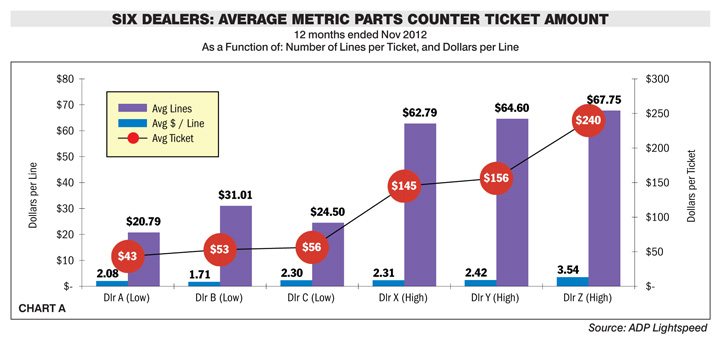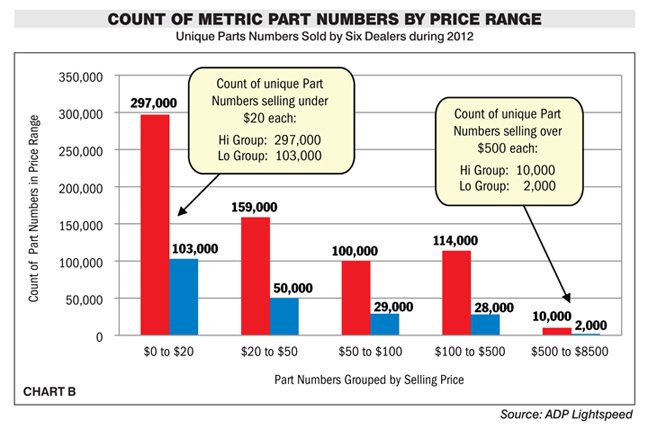Indy an ideal time to assess parts ticket averages
So, you’re going to Indy.
And you’re thinkin’ parties, and goodies, and shiny things, and girls who walk around wearin’ flashing lights and paint in funny places.
And, while that is all true, there is just a little more to it.
I get around to many of your stores during the year, and it is amazing to see the difference in how you handle your customers — and the difference that makes at the cash register. I recall two parts guys in an Eastern Shore Maryland shop. There were only the two of them on the counter, and one had an average ticket of around $65, while the other had an average ticket of only $45. Same number of customers, same number of hours on the counter. But a difference of about $20 as each customer walked away from the cash register.
Difference over the course of a year? Man A produced about $110,000 in margin in 12 months, while Man B contributed only $76,000. Guy B’s limitations were costing this owner $34,000 every year in lost margin, and he didn’t even know it.
Just like these two very different parts guys, every one of your stores has its own personality, its own way of thinking, and its own perception of what is good and what is bad. It is only when you step out of your own world and view yourself in a more complete light that you begin to realize that what you thought was good, just may not be that good!

For example, Chart A shows the performance between six different stores. They are from all over the country and all are metric. Each of them thinks they are doing a good job at selling parts, but they are worlds apart in the results the get.
The three stores on the left (Dealers A, B, and C) show average lines per ticket between 2.08 and 2.30. The dollars they sell per line run from $21 to $31 and their resulting average tickets (the red dots) range from $43 to $56. They each sell about 2,000 tickets per month, so their annual revenue is a little more than $1 million each, and their gross margin is just more than $400,000 each. Good job? Let’s see.
The next three dealers are arrayed on the right of the chart. They are running 2.31 to 3.54 lines per invoice, and the average dollars per line are $63 to $68 each. The average ticket for these three stores runs from $145 to $240, annual revenue is right at $3.5 million each, and gross margin comes in at $1.5 million each.
Now, what’s going on here? Why such differences?
The first obvious difference is the number of lines per invoice. The low group is running right at 2, while the high group is getting 2.76. It doesn’t seem like much, but the effect is huge. It appears to me that the parts crew at A, B and C is just showing up, opening the doors, standing behind the counter and taking orders.
But, the guys and gals at X, Y, and Z are there 45 minutes early. They have donuts and coffee. They sit with their sales team (“The Hot Shots”) and enjoy their goodies while the other guys eat nothing because they lost yesterday’s sales contest! And then they spend 30 minutes talking about features and benefits of the latest and greatest. It isn’t a lot — just one pair of boots, some new jackets and that new exhaust system that just came in. Then, the factory rep (yeah, he’s there too) takes a few minutes to explain warranty on parts and how to use that in selling expensive items. And after he’s done, the team that lost throws together a high-five, tries to grab some of the Krispy-Kremes, and grinning, they all walk toward the front doors that are just opening, to greet their customers and walk them through the clothing section and the bikes before taking them to the counter.
Any question about why the X, Y and Z crew is getting more out of the customers than are A, B and C? Now remember. We are talking about six real stores here. OK, maybe I made up a few details, but I’m betting that something just like this is really happening. You can see it in the numbers.
But what about the dollars per line? A, B and C are getting about $25 per line, while X, Y and Z are getting $51. Double! What is the difference here?
This is a little harder to figure out, but there are some clues.
Chart B compares the mix of high-priced parts and lower-priced parts sold by our two different dealer groups. Two obvious differences jump out. First, the Hi Average $/line group sells about three times the number of part numbers as does the Lo Average $/line group. The customer has triple the selection in our Hi stores, as he does in the Lo stores.

The second finding is at the far right of the chart. Here we see that the Hi group stocks and sells about 10,000 part numbers that range from $500 to $8,500 dollars each. The Low group? Only 2,000 such part numbers in this same range.
Now, just a word here. Closer inspection of these expensive parts shows a lot of kits, engines and heavy equipment that is not normally associated in the public mind with a motorcycle shop. But, OK. It’s a sale, isn’t it? These dealers on the high end have found things that active outdoor people want, and are willing to pay for. It had to get to the customer somehow, and these parts departments have found it, and are selling it through to them.
In other words, the stores with the higher per line average have found high-price, wide-ranging parts and non-vehicle equipment items and made them available to their customers. It may not be through stocking, but in some way they are getting word to their customers that they can deliver these things. And they do.
It will take more study to determine the full effect of this mix difference, but we all know about that empty wagon. And because of this, I have not excluded these high-priced, non-traditional items from this report.
So, you’re off to Indy. Meet with your people each morning. Map out the floor. Make assignments. Get out there, get back and report. Find those items that sell for more — high-ticket items that our customers really want, and will pay for. Learn about the new stuff (Can you say “UTV accessories?”). Get the sales points. Learn about related items. Get the features and the benefits. Highlight the literature and pass it around. Make this work for you.
But most importantly, figure out what your average lines per ticket are, and your average $/line before the show, and then after the show. Everything has to pay its own way. And Indy is no different.
And those girls wearing the flashing lights and the paint in funny places?
Fo’geddaboudit. They’re working too.
See you at the Show.
Hal Ethington has been associated with the powersports industry for more than 40 years. Ethington is a senior analyst at ADP Lightspeed. Contact him at Hal.Ethington@adp.com.








